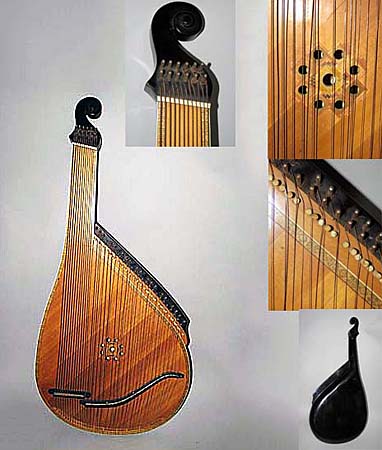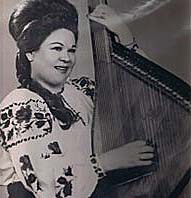

Owner: HWMC
Catalog#: CL-CHLT-29
Original owner and professional performer: Mrs. Tamara Crater – pictured with this (her) Bandura
Miscellaneous Lutes
Ukrainian Kyiv Style ‘Bandura’ Mrs. Tamara Crater
Ukraine
Eastern Europe
Wood, metal, pigment, bone
Mid-20th century
Length: 43.5 in, Width: 20 in, Depth: 3.25 in
Strings – Lutes – Miscellaneous
Label inside written in Ukrainian
Bandura (Ukrainian: Банду́ра) is a plucked string folk instrument, recognized as the National Musical Instrument of Ukraine. It combines elements of a harp and lute, much as its lute-like Baroque predecessor, the kobza.
The classical bandura became very popular among the Ukrainian Cossacks during the 19th-century and was often played in the courts of Poland and Russia. The first professional bandurist chorus was formed in Kiev, in 1918 during the height of Ukraine’s brief period of independence. However, a decade later, the chorus’ history rapidly evolved into a turbulent one. The ideals of the bandurist – God, truth, freedom, and human dignity, heralded through song – were a threat to the then-newly formed Soviet Union. Under Joseph Stalin’s rule, artists and intellectuals were arrested, exiled or executed in an attempt to eradicate every remnant of Ukrainian culture. The founder of the Bandurist Chorus, Hnat Khotkevych (1877-1938), a prominent writer, ethnographer, and composer, was executed in 1938 in Kharkiv and his compositions were banned throughout the Soviet Union. Many conductors, chorus members, and blind bandurist-minstrels were also accused of enticing the populace to nationalism and were executed.
In the years that followed, the chorus was exploited and persecuted by both the Soviets and the Nazis. It was not until 1949 that through the assistance of allied forces many of the chorus members emigrated from refugee camps to the United States where many established a home base in Detroit, Michigan.
Freedom was a great blessing but not without its difficulties. Most of the members, in order to support their families, had to learn new skills that were often unrelated to their musical ability and experience. Approximately 90 percent joined Detroit’s automotive industry labor force. This, however, did not prevent the bandurists from launching a series of concerts in their newly adopted homeland. The Ukrainian Bandurist Chorus was reborn. Kytasty, Hryhory served as conductor and director of the chorus.
This vintage Ukrainian Kyiv Style Bandura comes from one of the original members of the Detroit Ukrainian Bandurist Chorus. (Mrs. Tamara Crater – pictured with the Bandura). Accompanying the instrument were programs of her touring performances, a history book, numerous pictures, and her personal diary – original owner/performer, Mrs. Tamara Crater.
